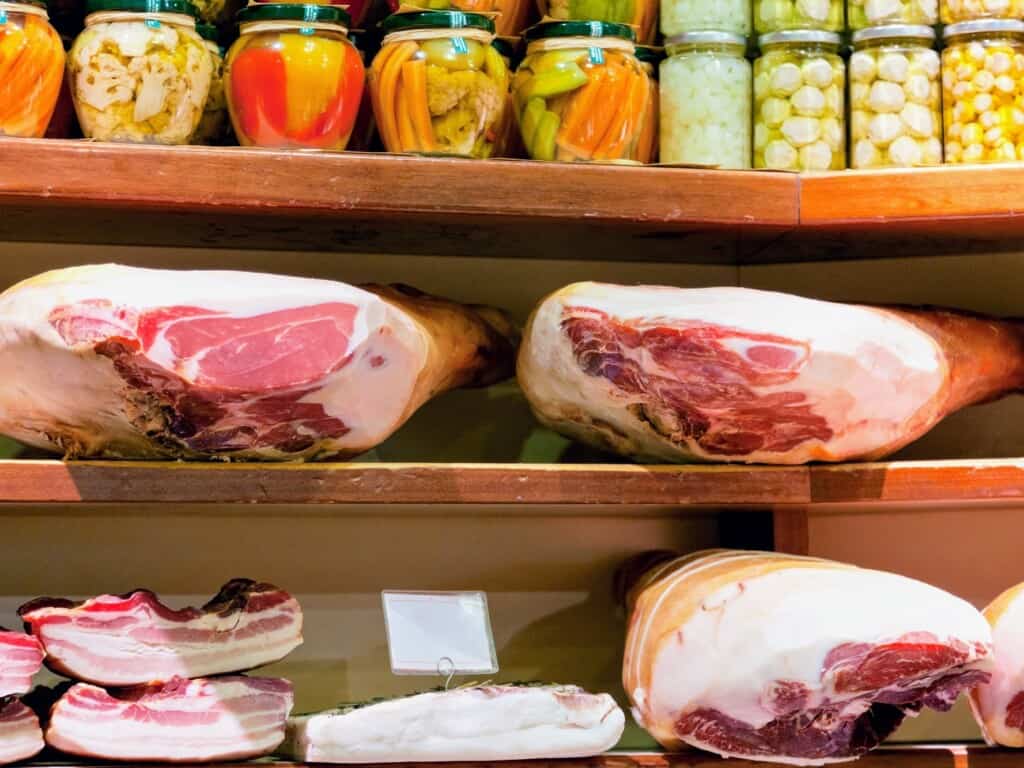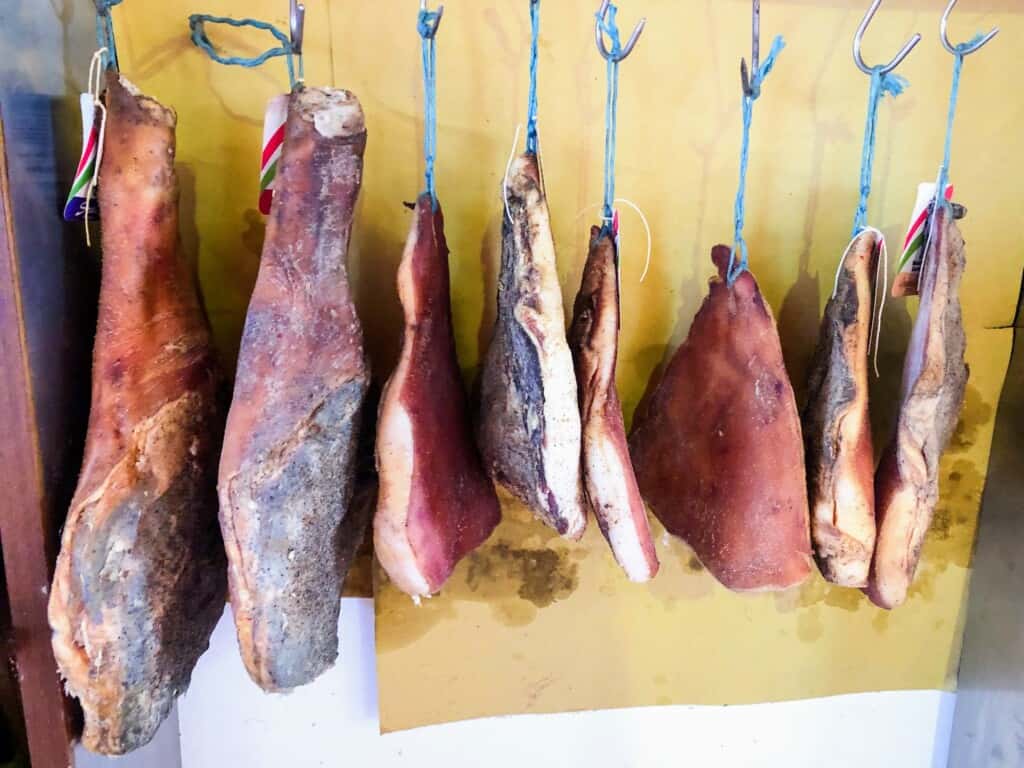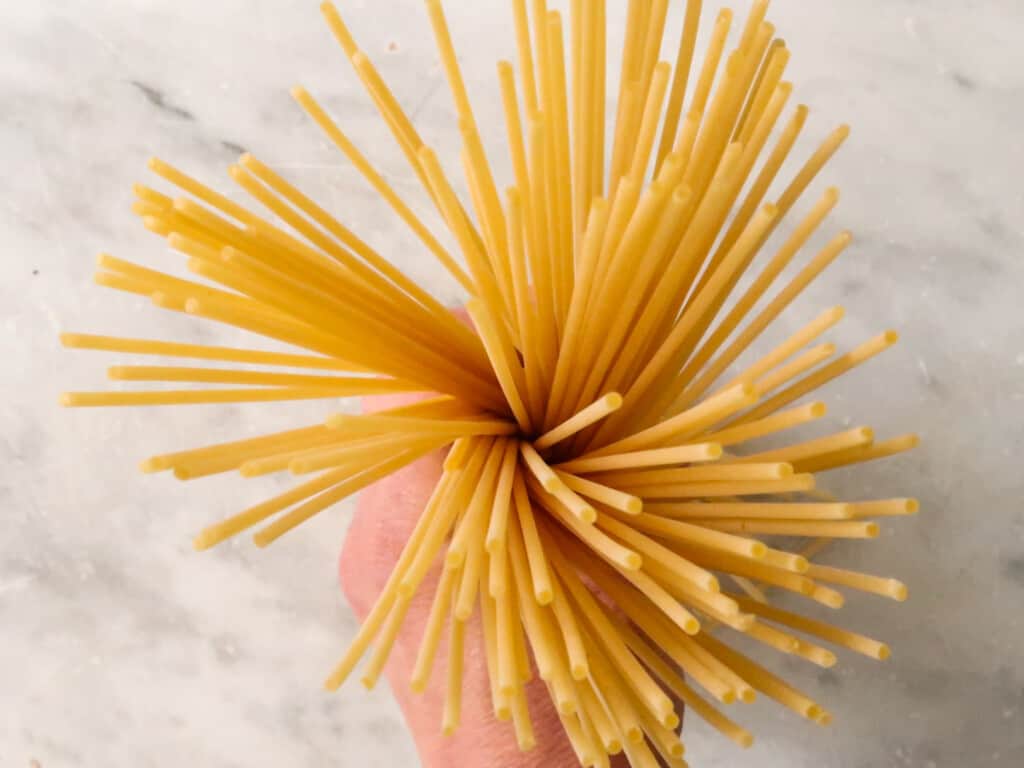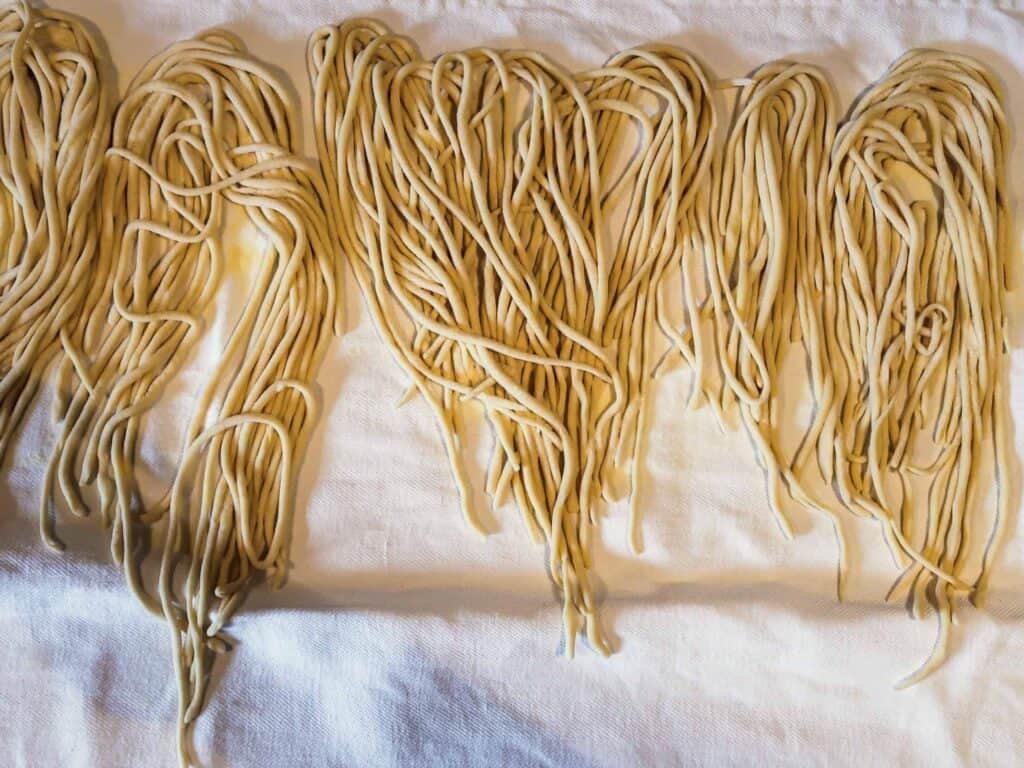Last updated on September 13th, 2023
Making prosciutto is a true artform here in Italy, crafted according to specific, regional recipes or passed down from generation to generation.
Some types of prosciutto are salty, some sweet, some more heavily marbled and others more lean. And let’s not forget the spiced ones! This is only the tip of the iceberg when it comes to types of prosciutto.
In this article, I will go over prosciutto in Italy as a whole and then walk you through the most popular varieties that you’re most likely to encounter and see at the supermarket here.
Note: In this article, I am talking about cured Italian ham, not cooked ham. You can read all about the differences between cooked ham and cured ham in Italy.
Jump to Section
How To Pronounce Prosciutto In Italian
Prosciutto in Italian is pronounced proh-shoot-toh, literally translating to raw ham, prosciutto meaning “ham” and crudo meaning “raw”.
Listen to the pronunciation of prosciutto:
What Is Prosciutto?

In Italian, the term prosciutto means any kind of ham, cooked (cotto) or cured (crudo). In this article and when using just the term prosciutto in Italy, we are talking about the cured version, not cooked.
Fact: To specify cooked ham, you would order or say simply cotto in Italian.
Different types of prosciutto may have different names based on their geographical region of origin and any certification of quality production such as PDO and PGI.
Prosciutto is an air-cured bone-in ham taken from the hind legs of the pig, meant to last for an extended period of time. No matter the type of prosciutto, all are characterized by a deep red color, marbled with streaks of rich fat.
Prosciutto is not cooked with heat but rather, preserved through the process of curing. Prosciutto does not need to be cooked after purchase and can be eaten as is. It may seem raw but it’s 100% edible, even months after production!
Learn More: You may want to read Is Prosciutto Raw?
Prosciutto can further be subdivided between prosciutto dolce e prosciutto salato, sweet and savory versions of cured-hams.
Prosciutto Crudo Dolce
Prosciutto dolce means “sweet”, referring to prosciutto that is not as salty as other prosciutto recipes. It’s often considered more refined, mild and best sliced paper thin. Our family much prefers prosciutto dolce over salato.
Prosciutto Crudo Salato
Many rustic or ‘homemade’ prosciutto is seasoned heavily with salt and sometimes regional herbs and spices, making them even saltier and more flavorful. These varieties tend to be sliced thicker and sometimes by hand. This prosciutto is better paired with plain bread such as pane toscano that absorbs some of the saltiness.
Central Italian Travelers: If you are in a deli in Tuscany or Umbria, you can order locally made prosciutto sliced by hand instead of a machine.
Certified PDO and PGI Italian Prosciutto
There are several types of prosciutto in Italy that have been made and packaged in accordance with strict guidelines of Italian production. This includes the breed of the animal, how they are raised, the recipe that is used and how it’s cured. Either one or all of these production steps must be conducted within a specific geographical location in Italy to be awarded these stamps of quality approval.
- PDO (Protected Designation of Origin) certification is given to prosciutto that is produced in a specific location and adheres to exact phases of production that follow strict regulations (DOP in Italian)
- PGI (Protected Geographical Indication) certification is given to prosciutto that originate in a specific location with only one of the production phases taking place in this same geographical area according to looser guidelines (IGP in Italian).
Fact: PDO and PGI food products go through strict quality control checks, making them much more expensive than other types of prosciutto.
What Does Prosciutto Crudo Taste Like?

The taste varies significantly depending on the type of prosciutto you choose. As a basic sensory explanation, prosciutto is very salty with a melt-in-your mouth sensation.
Some types of prosciutto are spicier and more aromatic than others. If they are aged with herbs, they will be more flavorful and rich. Sweeter types of prosciutto are not so aromatic but rather, subtle and mild.
Good To Know: The longer prosciutto is aged, the more complex it will taste and the more expensive it will be!
Differences Between Types Of Prosciutto
Almost any factor can affect the flavor and texture of the prosciutto you eat. These are some of the largest factors to affect the final prosciutto:
- pig breed
- the diet and environment of the pig
- how it was slaughtered and butchered
- how it was salted
- the recipe used
- spices included
- for how long it was cured
- conditions of curing
- time elapsed in each step of production
- time elapsed between finished prosciutto and consumption
Fact: Different types of prosciutto are aged at different temperatures and humidity levels, both of which affect the final taste and texture of the cured prosciutto.
How Types Of Prosciutto Are Made

Each different type of prosciutto will adhere to different rules and regulations but the general process will always be the same.
- The hind pig’s legs are removed and cleaned well.
- The prosciutto leg is then salted by a master known as the Maestro Salatore and left to dry in a controlled environment.
- The prosciutto is washed by hand and seasoned again, according to a specific recipe that may or may not include other spices such as black pepper, garlic, juniper, rosemary or fennel.
- The prosciutto is then cured in a tightly controlled environment in terms of temperature and humidity, anywhere from 12-36 months.
- For PDO (DOP) viarites, prosciutto crudo goes through strict inspections and quality control measures at the end of the aging process.
- The prosciutto is packaged and distributed either in slices, chunks or as whole legs.
Fact: The amount of salt used to season the prosciutto depends on what kind of prosciutto is being made.
How To Buy Different Types Of Prosciutto

Different types of prosciutto can be purchased either pre-sliced, from the deli (which is the best option for travelers), in large pieces or even as a whole leg to be sliced at home either by hand or with a meat slicer.
My family has a meat slicer so we usually buy larger pieces of prosciutto di parma to slice as needed (which is on a daily basis for us!).
If you are a traveler, prosciutto (the type of prosciutto is indifferent) is at its best from the deli where you can be specific in the type of prosciutto and how you would like it sliced. For a quicky and easy shopping experience, pick up pre-packaged prosciutto slices.
Sliced meat in Italy is ordered by weight unless you just want one or two slices in which you would say vorrei solo due fette, per favore (I would just like two slices, please).
Good To Know: You can also ask for prosciutto sandwiches ‘to order’ at the deli in Italy if you see the bakery is located directly next to the deli meats. In this case, you can ask for a panino, indicate the bread you would like and then the meat. The employee will weigh each separately but create the simple sandwich for you (you can’t add other ingredients like cheese.

To order prosciutto, take a number and wait for it to be called. Indicate the name of the type of prosciutto you would like and how you would like it sliced, either paper thin (molto fine), thinly (fine), normale (normale) or thickly (alto).
Prosciutto is ordered by weight increments of 100 or etti. For more information about grocery shopping in Italy, read Grocery Stores In Italy – Tips From A Local on How To Grocery Shop On Vacation.
Use this weight guide when ordering deli items such as types of prosciutto:
| Rough weight in pounds (lbs) | Italian Weight Measurement | Italian Pronunciation | English Translation |
| ¼ lbs | un etto | oon eht-toh | 100 grams |
| ½ lbs | due etti | doo-eh eht-tee | 200 grams |
| ⅔ lbs | tre etti | treh eht-tee | 300 grams |
| 1 lbs | mezzo kilo | mehz-zoh kee-loh | ½ kilogram |
| 2 lbs | nove etti | noh-veh eht-tee | 900 grams |
For example:
Vorrei due etti di prosciutto di Parma tagliato molto fine, per piacere.
(I would like ½ pound of prosciutto di Parma cut paper thinly, please.)
Vorrei un etto di prosciutto Toscano tagliato a mano, per favore.
(I would like ½ pound of prosciutto toscano cut by hand, please).
You can also indicate grams instead of etti:
Vorrei 100 grammi di prosciutto di San Daniele tagliato fine.
(I would like 100 grams of prosciutto di San Daniele cut thinly, please).
Types Of Prosciutto

There are several types of prosciutto crudo in Italy, all of which follow different regional recipes of curing.
| Type Of Prosciutto | Pronunciation | Origin | Certification | Availability Abroad |
| Prosciutto di Parma | proh-shoot-toh dee pahr-mah | Parma (Emilia-Romagna) | PDO | Common |
| Prosciutto di San Daniele | proh-shoot-toh dee sahn dahn-yeehl-eh | Friuli-Venezia-Giulia | PDO | Fairly Common |
| Prosciutto Toscano | proh-shoot-toh toh-skah-noh | Tuscany | PDO | Difficult |
| Prosciutto di Modena | proh-shoot-toh dee moh-deh-nah | Modena (Emilia-Romagna) | PDO | Difficult |
| Prosciutto di Carpegna | proh-shoot-toh dee cahr-pen-yeeah | Le Marche | PDO | Difficult |
| Prosciutto di Norcia | proh-shoot-toh dee nohr-chyah | Norcia (Umbria) | PGI | Difficult |
| Prosciutto Veneto Berico-Euganeo | proh-shoot-toh veh-neh-toh beh-ree-coh ehoo-gahn-eh-oh | Veneto | PDO | Difficult |
| Prosciutto di Sauris | proh-shoot-toh dee sawoo-rees | Friuli-Venezia Giulia | PGI | Difficult |
| Jambon de Bosses | shjahm-bohn deh bohs | Aosta Valley | PDO | Easier within boarding Italian countries |
Prosciutto di Parma PDO
Listen to the pronunciation of prosciutto di Parma:
Origine: Emilia-Romagna
Prosciutto di Parma is made from a particular heritage pig breed that eats a diet primarily based on chestnuts in only designated areas of northern Italy. This sweet, PDO prosciutto, is considered the king of all cured hams, being one of the best and most available types of prosciutto on the international market. Each individual prosciutto goes through a rigorous quality check before being approved for the market, which is only one of the many reasons it fetches such a high per kilo price!
Fact: Prosciutto di Parma must be aged for at least one year but it can be aged for up to three!
Prosciutto di San Daniele PDO
Listen to the pronunciation of prosciutto di San Daniele:
Origine: Friuli-Venezia Giulia
Prosciutto di San Daniele is characterized by its unique shape, similar to a guitar, created by pressing the meat after it has been salted. Produced in the province of Udine, prosciutto di San Daniele is richer and darker than other types of prosciutto. This sweet variety is delicate and just like the Parma prosciutto, it should be enjoyed sliced paper thin with sweet fruits such as figs and melons.
Prosciutto Toscano PDO

Listen to the pronunciation of prosciutto toscano:
Origine: Tuscany
Prosciutto Toscano is more of a savory version, flavored with pepper, rosemary and juniper in the salting process, made with pigs born and raised strictly within Tuscan borders. It’s salted and air-cured for roughly 12-16 months while other types of prosciutto may only be salt-cured. Because of this, the prosciutto Toscano looks differently than other types of prosciutto, with a thicker layer of pink fat (compared to other white colors of fat in different varieties)
It’s quite salty and spicy with a very pungent aroma, pairing particularly well with pane toscano.
Prosciutto di Modena PDO
Listen to the pronunciation of prosciutto di Modena:
Origine: Emilia Romagna
Prosciutto di Modena is made from the Large White, Landrace and Duroc pig breeds around the Panaro river in the provinces of Modena, Bologna and Reggio Emilia. Known for its intense, rich aroma and delicate flavor, prosciutto di Modena is cured for a longer period of time than other types of prosciutto, about 14 months.
Prosciutto di Carpegna PDO
Listen to the pronunciation of prosciutto di Carpegna:
Origine: Le Marche
Prosciutto di Carpegna, named after the town of Carpegna, is made from the Pesante Padano pig breed solely in the Marche region. This type of prosciutto is then salted twice and left to age for at least 13 months. It’s characterized by its exterior coated in lard flavored with different spices.
Prosciutto di Norcia PGI
Listen to the pronunciation of prosciutto di Norcia:
Origine: Umbria
The preservation of meat is an ancient practice in Umbria where winters can be harsher on small, hilltop towns. Prosciutto di Norcia, produced in the province of Perugia, particularly in Norcia in the Valnerina valley, is aged for up to 12 months and defined by its particularly salty flavor.
Prosciutto Veneto Berico-Euganeo PDO

Listen to the pronunciation of prosciutto Veneto Berico-Euganeo:
Origine: Veneto
Prosciutto Veneto Berico-Euganeo, produced solely in the provinces of Padova, Vicenza and Verona, is delicate and refined, ideally served raw on a tagliere or charcuterie board with the local bread pan biscotto.
Prosciutto di Sauris PGI
Listen to the pronunciation of prosciutto di Sauris:
Origine: Friuli-Venezia Giulia
Prosciutto di Sauris are made from the Large White, Landrace and Duroc pig breeds (same as prosciutto di Modena). This prosciutto is cured first with salt and then with smoke, a tradition rooted in Germanic and Austrian practices of curing meat. The additional smoking gives the prosciutto a golden shade with various shades of pink and white fat marbling.
Jambon de Bosses PDO
Listen to the pronunciation of jambon de Bosses:
Origine: Aosta Valley
From the small town of Saint-Rhémy-en-Bosses in the Gran San Bernardo Valley close to the Swiss border, Jambon de Bosses has been around ever since the Middle Ages. Flavored with pepper, sage, rosemary, garlic, juniper, thyme and bay leaf, the aroma of jamon de Bosses is delicate and sweet. It’s best paired with the regional cheese Fontina PDO or Fromadzo PDO as an appetizer.
Culatello di Zibello – A Prosciutto Imposter
While at first glance you will see Culatello di Zibello listed as one of the best types of prosciutto on the market, it’s actually considered a salumi because it’s stuffed into a natural casing (usually a pig’s bladder).
Made in Parma, Culatello di Zibello is very buttery and rich with a well-balanced flavor.
Best Ways To Eat Types Of Prosciutto
The absolute best way to eat prosciutto is in paper thin slices, allowing the cured meat to melt on your tongue, slowly releasing its aromatic and complex flavors.
Exception: In central Italy such as Tuscany and Umbria where the prosciutto is much saltier, it’s often cut by hand and enjoyed in thicker slices.
How Best To Eat Types Of Prosciutto

It’s best to eat prosciutto raw, rather than cooking it in recipes. Here are the most common ways you will find different types of prosciutto in Italy:
- prosciutto e melone – with melon
- prosciutto e fichi – with figs
- tagliere – charcuterie board
- crostini
- pizza or pinsa– added after cooking
- panini – sandwiches
What To Pair With Different Types Of Prosciutto

Because of Prosciutto’s aromatic flavors, it pairs well with more mild and sweet ingredients such as light cheese: mozzarella, burrata, and fruit like melon, figs, pears.
Wine Pairings: Different types of prosciutto pair best with different wines that are also produced side-by-side the cured ham within the same region. Your best gamble is to ask for a regional wine that holds up well to that same regional prosciutto.
Types Of Prosciutto FAQ
The most famous and well-known type of prosciutto is prosciutto di Parma from Emilia-Romagna. It’s a sweet variety with a very light and well balanced flavor. Luckily, it’s the most popular prosciutto abroad, making it easy to enjoy also outside of Italian borders.
There are two types of prosciutto in Italy: prosciutto cotto, which is cooked. and prosciutto crudo, which is preserved through curing. Within the category of prosciutto crudo, there are several types of prosciutto, the most famous being prosciutto di Parma and prosciutto di San Daniele.
It depends on the country but generally speaking you cannot bring cured meats outside of the EU, even if they are vacuum-packed. Check your country’s customs rules and regulations.
The most beloved, prized and famous prosciutto in Italy is prosciutto di Parma and prosciutto di San Daniele but I highly suggest you buy the local prosciutto of the region that you are touring in that moment. It’s wonderful to try all the different kinds but you will find the best of the best within the region that a specific type of prosciutto is produced. For example, when in Tuscany, eat prosciutto Toscano and when in Umbria, eat prosciutto di Norcia.




